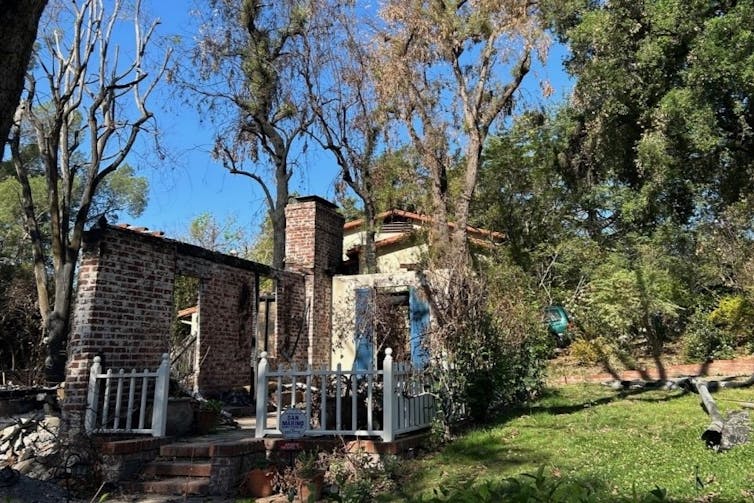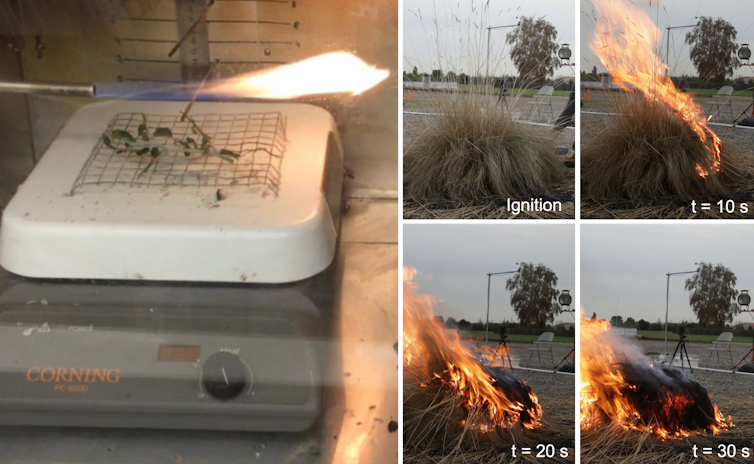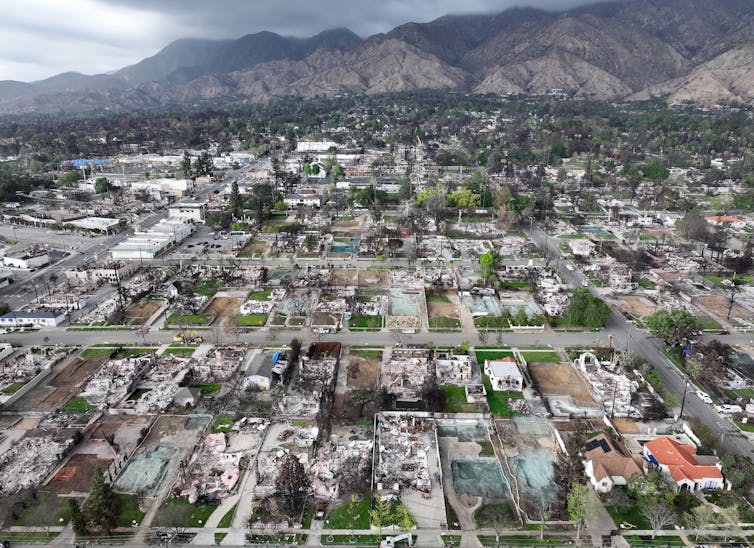One of the putting patterns within the aftermath of many city fires is how a lot unburned inexperienced vegetation stays amid the wreckage of burned neighborhoods.
In some instances, a row of shrubs could also be all that separates a surviving home from one which burned just some ft away.
As scientists who examine how vegetation ignites and burns, we acknowledge that well-maintained vegetation and bushes can truly assist shield houses from wind-blown embers and sluggish the unfold of fireside in some instances. So, we’re involved about new wildfire safety rules being developed by the state of California that may prohibit nearly all vegetation and different flamable materials inside 5 ft of houses, an space generally known as “Zone 0.”
Max Moritz; CAL FIRE Injury Inspection images, CC BY
Wildfire security pointers have lengthy inspired owners to keep away from having flammable supplies subsequent to their houses. However the state’s plan for an “ember-resistant zone,” being expedited below an government order from Gov. Gavin Newsom, goes additional by additionally prohibiting grass, shrubs and plenty of bushes in that space.
If that prohibition stays within the ultimate regulation, it’s prone to be met with public resistance. Getting these guidelines proper additionally issues past California, as a result of rules that originate in California usually ripple outward to different fire-prone areas.
Classes from the devastation
Analysis into how vegetation can cut back fireplace danger is a comparatively new space of examine. Nevertheless, the findings from plant flammability research and examination of patterns of the place vegetation and houses survive giant city fires spotlight its significance.
When surviving vegetation do seem scorched after these fires, it’s usually on the facet of the plant going through a close-by construction that burned. That implies that wind-blown embers ignited homes first: The homes have been then the gas as the fireplace unfold by the neighborhood.
We noticed this repeatedly within the Los Angeles space after wildfires destroyed 1000’s of houses in January 2025. The sample suggests a have to deal with the various components that may affect dwelling losses.

Max Moritz
A number of guides can be found that specify steps owners can take to assist shield homes, significantly from wind-blown embers, generally known as dwelling hardening.
For instance, putting in rain gutter covers to maintain useless leaves from accumulating, avoiding flammable siding and making certain that vents have screens to stop embers from stepping into the attic or crawl area can decrease the danger of the house catching fireplace.
Nevertheless, steerage associated to landscaping vegetation varies tremendously and may even be incorrect.
For instance, some “fire-safe” plant lists comprise species which might be drought tolerant however not essentially fireplace resistant. What issues extra for protecting vegetation from changing into gas for fires is how properly they’re maintained and whether or not they’re correctly watered.
How a plant bursts into flames
When dwelling plant materials is heated by a close-by power supply, akin to a hearth, the moisture inside it should be pushed off earlier than it may ignite. That evaporation cools the encompassing space and lowers the plant’s flammability.
In lots of instances, excessive moisture can truly hold a plant from igniting. We’ve seen this in a few of our experimental work and in different research that check the flammability of decorative landscaping.
With sufficient warmth, dried leaves and stems can break down and volatilize into gases. And, at that time, a close-by spark or flame can ignite these gases and set the plant on fireplace.

Max Moritz (left); Luca Carmignani (proper)
Even when the plant does burn, nonetheless, its moisture content material can restrict different facets of flammability, akin to how sizzling it burns.
As much as the purpose that they really burn, inexperienced, well-maintained vegetation can sluggish the unfold of a fireplace by serving as “warmth sinks,” absorbing power and even blocking embers. This obvious protecting function has been noticed in each Australia and California research of dwelling losses.
How usually vegetation buffers houses from igniting throughout city conflagrations continues to be unclear, however this functionality has implications for rules.
California’s ‘Zone 0’ rules
The Zone 0 rules California’s State Board of Forestry is creating are a part of broader efforts to cut back fireplace danger round houses and communities. They’d apply in areas thought-about at excessive danger of wildfires or defended by CAL FIRE, the state’s firefighting company.
Most of the newest Zone 0 suggestions, akin to prohibiting mulch and hooked up fences made from supplies that may burn, stem from large-scale assessments carried out by the Nationwide Institute of Requirements and Expertise and the Insurance coverage Institute for Enterprise and Dwelling Security. These options will be systematically analyzed.
However vegetation is much tougher to mannequin. The state’s proposed Zone 0 rules oversimplify complicated situations in actual neighborhoods and transcend what’s at the moment identified from scientific analysis relating to plant flammability.

Mario Tama/Getty Pictures
A mature, well-pruned shrub or tree with a excessive crown might pose little danger of burning and may even cut back publicity to fires by blocking wind and warmth and intercepting embers. Aspen bushes, for instance, have been really useful to cut back fireplace danger close to constructions or different high-value property.
In distinction, dry, unmanaged vegetation below home windows or close to fences might ignite quickly and make it extra probably that the home itself will catch fireplace.
As California and different states develop new wildfire rules, they should acknowledge the protecting function that well-managed vegetation can play, together with many different advantages of city vegetation.
We imagine the California proposal’s present emphasis on extremely prescriptive vegetation elimination, as an alternative of on upkeep, is overly simplistic. With out complementary necessities for hardening the houses themselves, widespread clearing of landscaping instantly round houses might do little to cut back danger and have unintended penalties.![]()
Moritz, Wildfire Specialist, College of California Cooperative Extension; Adjunct Professor on the Bren Faculty, College of California at Santa Barbara, College of California, Santa Barbara and Luca Carmignani, Assistant Professor of Engineering, San Diego State College
This text is republished from The Dialog below a Artistic Commons license. Learn the unique article.
High photograph: Photographs after the Los Angeles fires in January 2025 present many yards the place vegetation didn’t burn whereas neighboring homes did.
AP Photograph/Chris Pizzello.
Copyright 2025 Related Press. All rights reserved. This materials will not be printed, broadcast, rewritten or redistributed.

